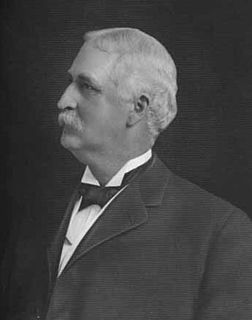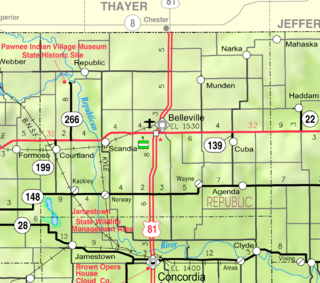
Joseph W. Reinhart (1851-1911) was the twelfth president of the Atchison, Topeka and Santa Fe Railway. He served as head of the Santa Fe from December 1893 until August 1894.

Joseph W. Reinhart (1851-1911) was the twelfth president of the Atchison, Topeka and Santa Fe Railway. He served as head of the Santa Fe from December 1893 until August 1894.
Joseph W. Reinhart was born in Pittsburgh, Pennsylvania on September 15, 1851. He was a graduate of Western University of Pennsylvania, today known as the University of Pittsburgh. [1]
Following graduation, Reinhart entered the field of railroad management, beginning in 1875 as a clerk in the office of a division superintendent of the Allegheny Valley Railroad. [1] Thus began a career in which Reinhart worked for more than 20 railroads. [1]
Reinhart ascended to the Santa Fe's presidency on December 23, 1893, when he was appointed a receiver of the railroad along with John J. McCook and Joseph C. Wilson. He had competed for the presidency with Albert Alonzo Robinson, the railroad's vice president and general manager, but Reinhart's connections in financial circles made him the ultimate winner of this battle.
Reinhart's own statements to the press in the previous year about the railroad's financial health would prove to be his downfall. Right up until he announced the receivership, Reinhart had been issuing reports of a highly profitable financial situation. He pointed out that the railroad's revenues for the fiscal year ending June 30, 1893, were more than $16 million, which was $1 million more than the previous year. However, with that amount in revenues, the railroad was barely able to cover the interest on its debts and collapsed with the death of its chairman George C. Magoun.
The press needed someone to blame and quickly centered on Reinhart as the issuer of the glowing statements of solvency as little as six months previous. Investigations were begun and it was soon found that executives in as many as the past seven years had juggled the company's accounts so that by the summer of 1894, the railroad's actual debt in the previous years had at least equalled its revenues, leaving the company's net worth at zero. Reinhart vehemently denied these new reports, but after further posturing and an indictment for violating the Interstate Commerce Act, Reinhart resigned from the railroad on August 8, 1894.
Reinhart died at his home in Kansas City, Missouri on January 27, 1911. [1] He was 59 years old at the time of his death, which was attributed to pneumonia and bronchitis which followed a severe cold which he caught in New York City two weeks previously. [1]
At the time of his death, Reinhart was serving as the President of the Kansas City Viaduct and Terminal Company. [1]

Marion County is a county located in the U.S. state of Kansas. Its county seat is Marion and its most populous city is Hillsboro. As of the 2020 census, the county population was 12,660. The county was named in honor of Francis Marion, a brigadier general of the American Revolutionary War, known as the "Swamp Fox".

The Atchison, Topeka and Santa Fe Railway, often referred to as the Santa Fe or AT&SF, was one of the larger railroads in the United States. The railroad was chartered in February 1859 to serve the cities of Atchison and Topeka, Kansas, and Santa Fe, New Mexico. The railroad reached the Kansas–Colorado border in 1873 and Pueblo, Colorado, in 1876. To create a demand for its services, the railroad set up real estate offices and sold farmland from the land grants that it was awarded by Congress.

William Barstow Strong served as president of the Atchison, Topeka and Santa Fe Railway from 1881 to 1889. He is often referred to as either William B. Strong or W. B. Strong.

Colonel Cyrus Kurtz Holliday was an American railroad executive who was one of the founders of the township of Topeka, Kansas in the mid 19th century; and was Adjutant General of Kansas during the American Civil War. The title Colonel, however, was honorary. He was the first president of the Atchison, Topeka and Santa Fe Railway, as well as one of the railroad's directors for nearly 40 years, up to 1900. A number of railway locomotives have been named after him, as well as the former town of Holliday, Kansas. He was also the Deputy Grand Master of the Grand Lodge A.F. & A.M. of Kansas. As a Freemason, he was a member of Topeka Lodge #17 and was highly influential in the decision of moving the State Capitol to the city of Topeka.

Ginery Twichell was president of the Boston and Worcester Railroad in the 1860s, the Republican Representative for Massachusetts for three consecutive terms and the sixth president of the Atchison, Topeka and Santa Fe Railway.
Thomas Nickerson was the eighth president of the Atchison, Topeka and Santa Fe Railway between 1874 and 1880. He was also president of the Atlantic and Pacific Railroad.

The Santa Fe de Luxe was the first extra-fare named passenger train on the Atchison, Topeka and Santa Fe Railway.
Allen Manvel was the eleventh president of the Atchison, Topeka and Santa Fe Railway.

George C. Magoun was, in the late 1880s, the Chairman of the Board of the Atchison, Topeka and Santa Fe Railway.

Albert Alonzo Robinson, sometimes referred to as Albert A. Robinson or A. A. Robinson, was an American civil engineer who rose through the ranks of the Atchison, Topeka and Santa Fe Railway to eventually become the railroad's vice president and general manager. After resigning from the Santa Fe, Robinson became president of the Mexican Central Railway.

Aldace Freeman Walker was one of the original members of the Interstate Commerce Commission (ICC) when the organization was founded in 1887. Walker soon became the thirteenth president of the Atchison, Topeka and Santa Fe Railway.

Edward Payson Ripley, sometimes referred to as Edward P. Ripley or E. P. Ripley, was the fourteenth president of the Atchison, Topeka and Santa Fe Railway.
William Benson Storey, Jr. was the fifteenth president of the Atchison, Topeka and Santa Fe Railway.

William Thornton Kemper Sr. was an American banker who was the patriarch of the Missouri Kemper family, which developed both Commerce Bancshares and United Missouri Bank to become a major banking family in the Midwest.

Kackley is an unincorporated community in Republic County, Kansas, United States. It is located southeast of Courtland at Co Rd 5 and K-148 highway.
The following is a brief history of the North American rail system, mainly through major changes to Class I railroads, the largest class by operating revenue.